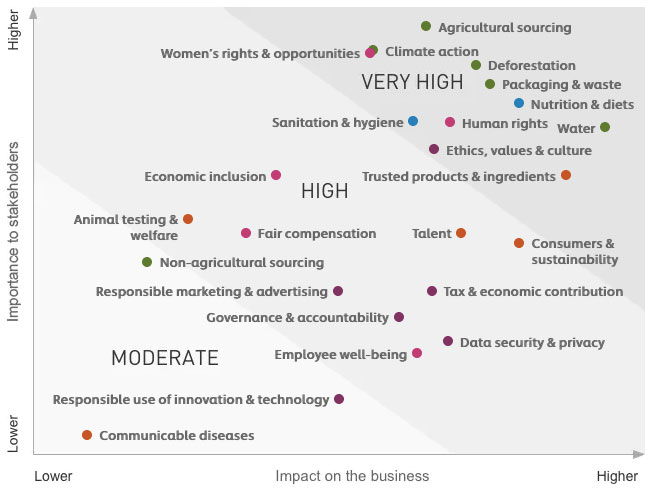What is a materiality analysis? Why is it an important tool for stakeholder engagement? Is it necessary for CSR reports? What are the benefits of materiality assessment?
Official Definition Of Materiality According to GRI (Global Reporting Initiative)
‘Materiality’ are “those topics that have a direct or indirect impact on an organization’s ability to create, preserve or erode economic, environmental and social value for itself, its stakeholders and society at large”. GRI G4 guidelines
Simple Definition Of Materiality Analysis
A materiality analysis is a method to identify and prioritize the issues that are most important to an organization and its stakeholders.
An Overview On What A Materiality Analysis Is
Materiality means analyzing which issues are the most important of being addressed by businesses. After identifying potential sustainability issues thought to be directly relevant to an organization’s value chain, these issues are analyzed using 2 different lenses. So for issues such as reducing plastic packaging, sharing wealth or working with sustainable suppliers, the organization needs to evaluate: 1) what’s the potential of each issue to positively or negatively impact organizational growth, cost, or trust and 2) how important is each issue to stakeholders. The ultimate result is a visual representation of which issues should be prioritized according to their importance to the company’s success and stakeholders’ expectations (that can directly affect the first).
In other words, a materiality analysis is a methodology a company can use to identify and estimate possible Environmental, Social and Governance (ESG) which might impact the business and its stakeholders. As EY puts it, companies need to ask whether the issues to cover in the sustainability report and disclosures are important enough to influence a stakeholder’s decisions in relation to the business. As a result of this analysis, companies can create their long-term ESG strategy, targets and find the best strategies to report the data found as a result of the process.
The Benefits Of Taking a Materiality Analysis
- It’s an opportunity to analyse business risks and opportunities, and to eventually readjust and improve thei business strategy;
- It’s a chance to understand where organizations are creating or reducing value for society;
- It’s a way of making a business case to senior executives about why and how to report ESG data;
- It provides the knowledge and means on how to measure different performances (financial, social and environmental);
- It inherently means spotting trends and, therefore, anticipating emerging issues;
- Assessing the opportunities ahead allows for the development of new products or services and, therefore, staying ahead of the competition;
- It allows organizations to focus their efforts on allocating resources better;
- The analysis will allow companies to meet the sustainability reporting expectations of stakeholders;
- It increases the chances of better satisfying stakeholders’ demands;
- The results and data from the materiality assessment can be used to design content for CSR Reports or for communications with individual stakeholder groups like investors, partners, customers or employees.
Example Of Materiality Analysis: A Materiality Matrix

As we’ve discussed above, a materiality analysis and the materiality matrix that results from it allows an organization to decide on which sustainability issues to focus on and invest time in. The materiality matrix showcases these sustainability issues by contrasting two dimensions. One is the importance of the issue to the organization regarding the expected influence this issue will have on the organization’s success. The second is the importance or attractiveness of the issue to stakeholders and the likely influence they might have, as a result of the working efforts (or lack of them) on this issue, on business success.
There Is a Growing Demand For Materiality Analysis
The science is clear: GHG emissions have been rising for years and they need to start decreasing 3.5% between 2020 and 2030 so the average temperature on the planet doesn’t increase over 2ºC until the end of the century. And the consequences of the current temperature increase are already being felt by cities that are flooding (like Venice), forests burning at unprecedented scale (like the Amazonia and Californian forests), people dying because of heat waves (India) or agriculture sites whose yields are decreasing.
The population’s awareness of these issues is increasing and people are raising their voices to ask/demand change to happen. And one of the actors they’re expecting actions are businesses, which are also being asked to show more transparency and to adopt socially-fair practices. Several polls are showing consumers are increasingly choosing brands whose values (and effective actions) align with those of their own. This is one of the reasons why it is crucial for the long term survival of businesses that they adapt to stakeholders’ expectations, identify their impact and reduce it.
Another reason is that there are effectively internal risks that need to be taken into consideration. As temperatures increase, reefs die and 200 species of plant, insect, bird, and mammal go extinct every day, the ecosystem services are at risk – and so are entire supply chains dependant on raw materials, and, therefore, businesses. And that’s my investors are increasingly asking for ESG metrics and information coming from tools such as materiality analysis before they decide to invest.
- [Image credits to Shutterstock on team]